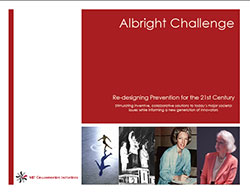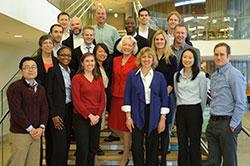2013 Albright Challenge
2013 Challenge
2013 Albright Challenge Photos
AC Team A Final Presentation, April 12, 2013
AC Team B Final Presentation, April 12, 2013
Phase 1 of the 2013 Albright Challenge was held in Cambridge at the Broad Institute of MIT and Harvard. 18 Participants from across the country gathered together for an intense 5 day session. Sponsored by Coca-Cola, State Street, Dell-Wyse Corporation and EMC Corp..
2013 Albright Challenge Topic: 2013 Albright Challenge Topic: Intersection of education/environment and well-being. In the U.S. we are challenged by an education system with huge disparities in quality, access and achievement and looming environmental issues, which threaten the very quality of life. The inaugural Albright Challenge will take a design driven view of the nexus of these two issues.
Based on the “studio model” developed at Helsinki Design Lab (“HDL”) of SITRA, the Finnish Innovation Fund, days 1 and 2 of the Challenge were focused on knowledge gathering. On Monday the teams broke into small groups and visited local organizations to get an “on the ground” view of the problems and possible solutions in real time. On Tuesday the teams were visited by a series of experts who joined in open dialogue with team members to share their experience and knowledge. Wednesday through Friday the teams got down to work on recommendations.
There was one critical difference between the Challenge and the HDL model. The original model was based on bringing together topic experts from a variety of backgrounds around a specific issue with fairly well defined parameters. The Albright Challenge brought together rising leaders from widely varied backgrounds to address an enormous, purposely broad, topic. They were given the topic and the directive to think outside the box and then break down the box all together.
The proof of the model is that the teams were able, in this compressed timeframe, to clearly define their view of the problem and a conceptual model for change. In doing so indelible friendships and contacts were formed.
Phase 2 of the Challenge: Ideas to Proposition, will take place from May to October while the Participants work to identify and expand on the top 5 to 10 actionable propositions which will be presented at MIT Collaborative Initiatives’ next New Models meeting on October 30, 2013.


